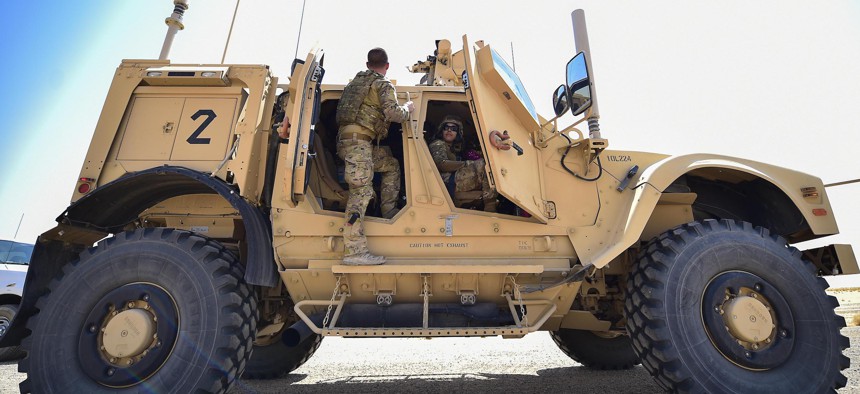
Airmen participate in a training scenario at Prince Sultan Air Base, Saudi Arabia, Sept. 4, 2020. Air Force Staff Sgt. Cary Smith
What Will Decrease Training Deaths? More Training, GAO Says
A recent increase in non-combat vehicle deaths could be reversed with more, better training, GAO’s newest report says.
A number of high-profile training mishap deaths in recent years drew attention to the Defense Department’s resurging problem with non-combat fatalities. The number of deaths in training vehicle accidents has more than doubled over the last two reported years, after hitting a 10-year low of seven in 2017.
After the Marine Corps amphibious assault vehicle accident that killed nine in July 2020 and the May 2019 death of Lt. Hugh Conor McDowell in a vehicle rollover, Congress requested that the Government Accountability Office report on these specific training deaths. Among the GAO’s findings, presented in a recent report, was that no “prescribed training regimen” is currently being implemented.
“You see very consistent causes—driver inattentiveness, supervision lapses, and the lack of training,” said Cary Russell, director of GAO’s Defense Capabilities and Management office. “When you look at what we’ve reported, there’s a lot of consistency in terms of application of safety practices and the lack of a good training program.”
The lack of an implemented training regimen means that building up the skills and knowledge needed to safely drive combat vehicles largely comes down to whatever training and experience each individual service member can luck into.
“It’s just catch-as-catch-can when it comes to the training that’s afforded to that driver and so as a result any given driver, their experience, their capabilities and proficiency is going to vary,” Russell said. “It can be very difficult sometimes to know how well a driver is suited for an intense training environment when you’re going to be doing a lot of stuff at night or in adverse environmental conditions.”
National Guard troops in particular, obtain less training than GAO believes may be necessary to safely operate combat vehicles—a problem that seemed likely to worsen as Congress grappled with how to refund the Guard the $520.9 million spent on sending Guard troops to Washington, D.C., following the Jan. 6 insurrection. Before President Joe Biden signed a funding bill last Friday, it looked like a significant portion of training for Guard troops would face funding cuts.
“If you cancel an annual training period, and two individual training periods the month of August and September for Guardsmen, you have in essence cut almost 50% of their training days that prepare them to deploy domestically and internationally in response to whatever missions that the president or the governor has set up for us,” Indiana Adjutant General Maj. Gen. Roger Lyles said during a media call on July 16.
And even without training cuts, Guard troops are facing unprecedented demands on their limited time as wildfire and hurricane seasons continue to worsen.
“There’s a potential for a real impact on their readiness,” Pentagon spokesperson John Kirby said shortly after Hokanson’s memo was released. “We’ve got wildfires and hurricane seasons coming...It’s already shaping up to be a busy summer for them,” Pentagon spokesperson John Kirby said last week as the Pentagon scrambled for Guard funds. “They have other demands on their time and their talents and their capabilities, so a degradation to their readiness and their ability to train is not good for the country and not good for the fellow citizens that they serve.”
Earlier this year, two Guard helicopter crashes in close succession killed six service members. Russell said GAO is now working on a report that will look specifically at Air and Army National Guard aviation safety factors, as requested by Sen. Chuck Schumer, D-N.Y., as a result of the crashes.
The Defense Department generally works to implement most of GAO’s recommendations to improve personnel readiness and safety—and a regimented training program with performance-based criteria is high up on the list of GAO’s recommendations to mitigate and prevent training accidents. In their responses to the report, Army and Marine Corps officials “concurred” with those specific recommendations and added that both branches already have formalized regulations for vehicle training but would “continue to review and refine training standards.”
If those specific recommendations are being implemented as GAO completes its most recent report on training accidents, Russell is confident that interviews with units will reflect some changes in training.
“We’ll just have to see; the data may or may not reflect it. But certainly if it’s out there while we’re talking to units and understanding the current environment hopefully that will come up,” he said.
NEXT STORY: GovExec Daily: The Gaps in Veteran Student Data







